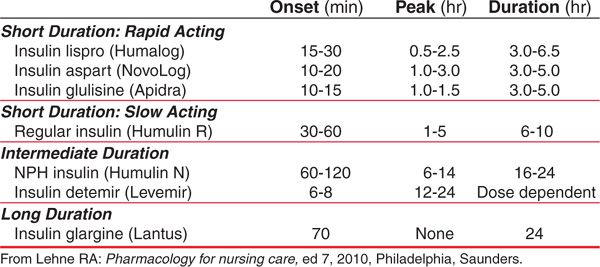Types of Insulin

ACTIONS
NURSING IMPLICATIONS
1. U100 insulin is the most common concentration.
2. NPH is the only cloudy insulin; roll vial gently between palms to mix.
3. *Draw up clear (regular, lispro—short acting) before the cloudy (intermediate) insulin to prevent contaminating a short-acting insulin with a long-acting insulin.*
4. Inject subcutaneously; aspiration is not necessary.
5. Avoid massaging the site after injection.
6. ‡Rotate sites within anatomic area; the abdomen is preferred for more rapid, even absorption.‡
7. *Only NPH (Humulin) can be mixed with short-acting insulins.*
8. *Only the short-acting insulins may be administered intravenous (IV).*
9. *Hypoglycemia is the primary drawback in maintaining tight control of glucose.*
10. *Store unopened vials of insulin in the refrigerator; vial currently in use should be stored at room temperature for 1 month.*
Sulfonylureas

• First generation—tolbutamide (Orinase), acetohexamide (Dymelor), chlorpropamide (Diabinese), tolazamide (Tolinase)
• Second generation—glipizide (Glucotrol), glyburide (Diabeta), glimepiride (Amaryl)
ACTIONS
Stimulates the beta cells of the pancreas to increase release of insulin. It also increases the sensitivity of peripheral insulin receptors, which increase insulin binding in the peripheral tissues. Second-generation medications act the same but are stronger.
USES
• Type 2 diabetes mellitus; may be used with other hypoglycemic conditions.
• Used as adjunct to diet and exercise programs to maintain glucose control.
CONTRAINDICATIONS AND PRECAUTIONS
• Not effective in patients with type 1 diabetes mellitus.
• Use with caution in patients with adrenal or pituitary insufficiency, or severe hepatic or renal impairment.
SIDE EFFECTS
• **Hypoglycemia**
NURSING IMPLICATIONS
1. ‡Instruct patient to take the drug 15 to 30 minutes before meals. Do not take medication and skip meals.‡
2. Self-monitor blood glucose (SMBG) levels three to five times daily.
3. Teach patient to maintain weight and dietary restrictions along with medication.
4. †Hypoglycemia (fatigue, hunger, cool moist skin, increased anxiety, dizziness, palpitations) should be treated immediately—take a fast-acting oral sugar (e.g., glucose tablets, orange juice).†
5. ‡If patient is not in the hospital and cannot swallow, emergency services (9-1-1) should be initiated.‡
Stay updated, free articles. Join our Telegram channel

Full access? Get Clinical Tree





